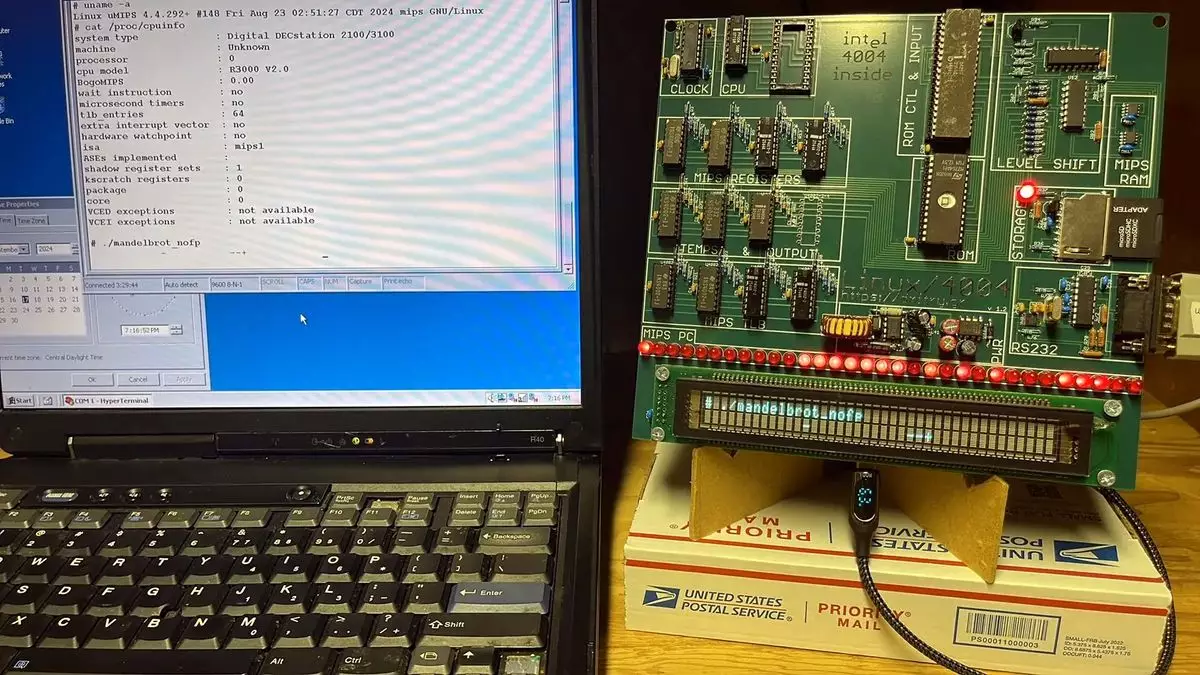In an era dominated by cutting-edge technology, the idea of reviving software for ancient hardware might seem both eccentric and impractical. Yet, one individual has taken on the quintessential challenge of adapting an operating system that emerged over three decades ago to operate on a processor that itself dates back to the early ’70s. Dmitry Grinberg’s recent endeavor to get the kernel of Debian Linux up and running on the Intel 4004 processor exemplifies a remarkable fusion of nostalgia and technical innovation. Though the project may lack immediate practical applications, it stands as a testament to human creativity and perseverance in the face of seemingly insurmountable obstacles.
Manufactured in 1971, the Intel 4004 was the first commercially available microprocessor, designed primarily for basic computing tasks. With a paltry 2,600 transistors at its disposal and a clock speed that barely reaches 790 kHz, the 4004 is at once an iconic artifact of engineering and a reminder of how far technology has come. This chip performs very few operations beyond simple arithmetic. Furthermore, it cannot effectively handle multitasking, offering no support for hardware interrupts. In essence, it is a bottleneck for modern software—which is precisely what makes Grinberg’s accomplishment so extraordinary.
Grinberg approached the daunting task of booting Debian Linux on the 4004 by adopting a unique workaround: creating an emulation environment that mimicked the capabilities of a MIPS R3000 processor, a chip contemporary with early versions of Linux and hence suitable for emulation. This creative thinking not only illustrates the inventive spirit underlying computing but also showcases Grinberg’s adept coding skills.
Setting a target of just 4 kB of RAM, he intricately crafted a program to replicate the necessary features of the R3000 within the constraints of the 4004. This approach inevitably demanded careful consideration of the hardware interface, requiring the integration of a custom circuit board and period-appropriate components that facilitated the project’s success.
Overcoming Speed Limitations
Multiple obstacles became apparent as the project progressed, with the most significant being the extreme slowness native to the Intel 4004. Initial calculations estimated that booting the Linux kernel would take nearly nine days—an overwhelmingly lengthy ordeal for what would traditionally be an instantaneous process in modern computing. Grinberg’s determination was steadfast. Through meticulous tweaks and optimizations, he managed to reduce the boot time to a still staggering 4.76 days.
Despite these improvements, it’s essential to appreciate the context. Viewing videos of Linux booting on this vintage setup, one is struck by the comical sense of time distortion; after all, how many people would willingly spend nearly five days waiting for a boot sequence? Yet, Grinberg was undoubtedly aware of the absurdity and embraced it, presenting his findings to audiences eager to witness a collision of engineering history and modern software.
What Grinberg ultimately showcases is not merely technical prowess but a passion for exploration and experimentation. His success emphasizes a broad spectrum of engineering possibilities, largely untouched by conventional commercial considerations. This project contributes to a legacy that champions not only the importance of nostalgia in technology but celebrates the notion that innovation need not always be tethered to profitability or utility.
As Grinberg reflects on his latest feat, one cannot help but wonder where his curiosity will lead him next. Perhaps he will embark on another whimsical journey—this time, bringing Doom to the 4004. Such a concept seems fitting, given both the historical importance of the game and Grinberg’s now-legendary status as a tech wizard. Whatever his next venture may be, it’s bound to spark intrigue and further push the boundaries of what we perceive as possible in the world of retro computing.

